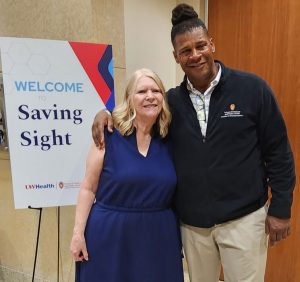For Jean Austin, the biggest problem with her failing eyesight was the inability to be outdoors in the sunshine because of painful glare.
Jean was diagnosed with Fuchs dystrophy 8 years ago. Fuchs Dystrophy is a condition in which fluid accumulates in the cornea, the clear tissue at the front of the eye. This causes the cornea to swell and thicken, often resulting in glare and blurred or cloudy vision. Symptoms typically progress slowly.
“For me, when I was out in the sun, my vision fractured,” Jean recalled. “And it became more and more painful for me to be out in the sun. So, I would only go out and do my grocery shopping and things on rainy or cloudy days. Basically, I stayed home when the sun was shining.”
Over time, Jean’s symptoms worsened.
“When my grandson announced he was getting married and the ceremony would be outdoors, I knew I would need surgery to be able to see the service,” Jean said. “I did a lot of research and watched a lot of videos, so I knew what to expect.”

The best treatment option for Jean’s condition was a partial-thickness corneal transplant in which the damaged cells are replaced with health cells from a deceased donor. In late 2023, Austin’s ophthalmologist referred her to UW Health cornea specialist Eric Weinlander, MD, FACS.

“I was very comfortable with Dr. Weinlander immediately,” Jean said. “He was thoughtful and thorough in answering all of my questions.”
“In Fuchs dystrophy, the cells lining the inside of the cornea – called endothelial cells – do not work as well,” Dr. Weinlander explained. “So fluid builds up within the cornea and small bumps, called guttae, develop on the inside layer of the cornea. A swollen cornea is hard to see through and the guttae scatter light, so patients with Fuchs dystrophy often experience blurry vision, disabling glare from lights, and an overall decline in sight. In Jean’s case, she had significant Fuchs dystrophy and cataracts, and both conditions played a role in her symptoms.”
Thanks to Lions Eye Bank of Wisconsin, Jean was able to get the cornea she needed quickly. LEBW is a non-profit organization dedicated to restoring sight through the recovery and transplantation of corneal tissue.
Dr. Weinlander completed the surgery on Jean’s left eye in April 2024.
“Jean’s cataract and cornea transplant surgeries went beautifully, and her recovery was smooth,” Dr. Weinlander said.
“Recovery occurred in stages,” Jean said. “I could see the second day. I could read my cell phone by the end of the third day. At two weeks I was feeling good, and I think I was driving again around 4 weeks later.”
Dr. Weinlander completed a transplant on Jean’s other eye two months later. And the results have been astounding.
“I have 20/20 vision for reading and computer work,” Jean said. “I do wear glasses for distance vision and driving. But the amazing thing for me are the colors. They’ve become so vibrant. I can’t believe how much my life has changed. My hope for the surgery was to be able to go outside again. And I can do so much more than that.”
“I was so touched to hear what a difference it made in her life,” Dr. Weinlander said. “It has been a joy to get to know Jean and her family, and it is truly an honor to take care of her.”